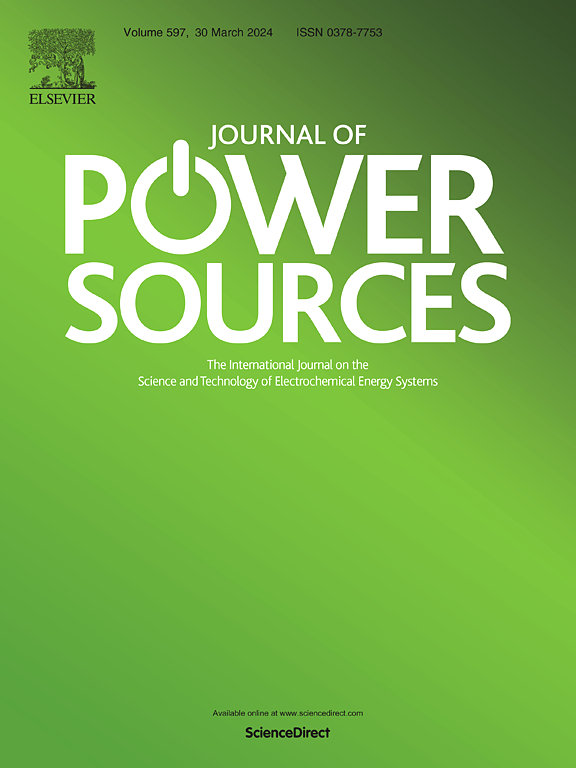TiO2/BiVO4双光阳极:扩展光收集和解决光电化学水分解的能带边缘错位
IF 8.1
2区 工程技术
Q1 CHEMISTRY, PHYSICAL
引用次数: 0
摘要
结合两种光催化剂形成异质结是提高水分解过程中光电化学性能的常用策略。然而,这种方法需要两种光催化剂之间合适的能带对准,这限制了它的有效性,甚至降低了性能,如不匹配的I型异质结所示。在这项工作中,我们设计了一种双光阳极结构,克服了TiO2/BiVO4异质结中通常形成的不利的I型带对准。利用脉冲激光沉积(PLD)技术,我们优化了沉积参数,使分别沉积在FTO衬底上的透明TiO2和BiVO4薄膜的光电流产生最大化。然后将两个光阳极连接并背靠背放置,TiO2光阳极面向光源,BiVO4光阳极被穿过TiO2层的光照射。在1.3 V vs. RHE下,TiO2/BiVO4双光阳极产生的光电流为1.72 mA/cm2,是TiO2/BiVO4异质结的2.3倍。同样,PEC产氢量增加到14.2 μmol cm−2 h−1,是单独BiVO4的2.25倍,是TiO2/BiVO4异质结的2.9倍。这种改进归功于双光阳极提供的扩展的光吸收和更大的活性表面积,同时避免了通常与I型异质结界面相关的载流子复合。本文章由计算机程序翻译,如有差异,请以英文原文为准。

TiO2/BiVO4 dual photoanodes: Extending light harvesting and addressing band edge misalignment for photoelectrochemical water splitting
Combining two photocatalysts to form heterojunctions is a common strategy to enhance the photoelectrochemical (PEC) performance in water splitting. However, this approach requires suitable band alignment between the two photocatalysts, which limits its effectiveness or even deteriorate the performance, as seen with mismatched type I heterojunctions. In this work, we design a dual photoanode configuration overcoming the unfavorable type I band alignment commonly formed in TiO2/BiVO4 heterojunctions. Using pulsed laser deposition (PLD), we optimized the deposition parameters to independently maximize photocurrent generation in transparent TiO2 and BiVO4 films, deposited separately on FTO substrates. The two photoanodes were then connected and positioned back-to-back, with the TiO2 photoanode facing the light source and the BiVO4 photoanode illuminated by light passing through the TiO2 layer. The TiO2/BiVO4 dual photoanode generates a photocurrent of 1.72 mA/cm2 at 1.3 V vs. RHE, 2.3 times higher than that of TiO2/BiVO4 heterojunction. Similarly, PEC hydrogen production increased to 14.2 μmol cm−2 h−1, which is 2.25 times higher than BiVO4 alone and 2.9 times greater than TiO2/BiVO4 heterojunction. This improvement is attributed to the extended light absorption and larger active surface area provided by the dual photoanode, while avoiding the charge carrier recombination typically associated with type I heterojunction interfaces.
求助全文
通过发布文献求助,成功后即可免费获取论文全文。
去求助
来源期刊

Journal of Power Sources
工程技术-电化学
CiteScore
16.40
自引率
6.50%
发文量
1249
审稿时长
36 days
期刊介绍:
The Journal of Power Sources is a publication catering to researchers and technologists interested in various aspects of the science, technology, and applications of electrochemical power sources. It covers original research and reviews on primary and secondary batteries, fuel cells, supercapacitors, and photo-electrochemical cells.
Topics considered include the research, development and applications of nanomaterials and novel componentry for these devices. Examples of applications of these electrochemical power sources include:
• Portable electronics
• Electric and Hybrid Electric Vehicles
• Uninterruptible Power Supply (UPS) systems
• Storage of renewable energy
• Satellites and deep space probes
• Boats and ships, drones and aircrafts
• Wearable energy storage systems
 求助内容:
求助内容: 应助结果提醒方式:
应助结果提醒方式:


